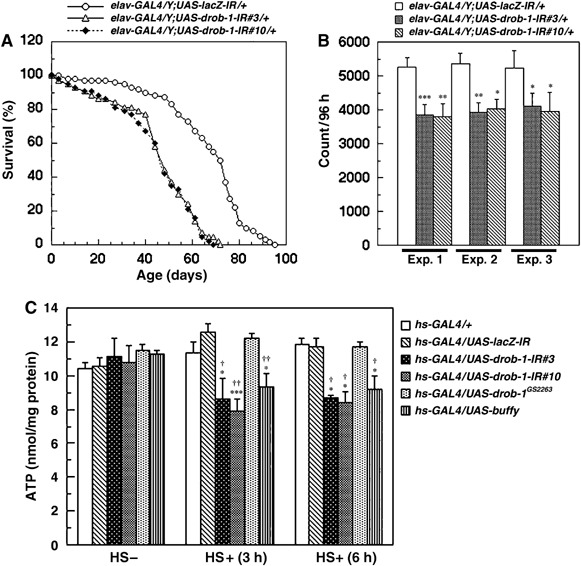Figure 1.

RNAi-mediated knockdown of Drob-1 results in a shorter lifespan, lower locomotor activity, and ATP depletion. (A) Expression of the UAS-drob-1-IR or UAS-lacZ-IR transgene was targeted to cells in the peripheral and central nervous systems using an elav-GAL4 driver. Two independent elav>drob-1-IR fly lines (#3 and #10) show significantly shorter lifespans than do control flies (elav>lacZ-IR). (B) Locomotor activity was analyzed using the DAM system as described in Materials and methods. Two independent elav>drob-1-IR fly lines (#3 and #10) show lower locomotion activity for 96 h (13–16 days after eclosion) than do control flies (elav>lacZ-IR). Each bar in the graph shows the mean±s.e.m. of 32 flies (n=32) of each genotype. Three independent experiments (Exp. 1–3) were performed. *P<0.05, **P<0.01, and ***P<0.005 relative to control by Student's t-test. (C) ATP levels in hs-GAL4/+, hs-GAL4/UAS-lacZ-IR, hs-GAL4/UAS-drob-1-IR#3, hs-GAL4/UAS-drob-1-IR#10, hs-GAL4/UAS-drob-1GS2263, and hs-GAL4/UAS-buffy adult flies (4 days after eclosion) 3 or 6 h after treatment with or without heat shock (twice at 37°C for 30 min with a 30 min interval) were measured as described in Materials and methods. Each value shows the mean±s.e.m. of three independent experiments. *P<0.05, **P<0.01, and ***P<0.005 for each value as compared with hs-GAL4/+, †P<0.05, ††P<0.01, and †††P<0.005 for each value as compared with hs-GAL4/UAS-lacZ-IR by Student's t-test. GS2263 is a fly line that can overexpress untagged Drob-1 in a GAL4-dependent manner.
